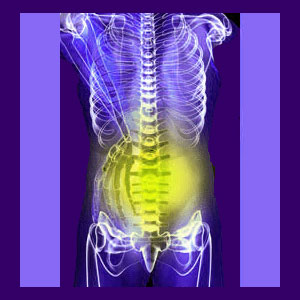
Spondylolisthesis lower back pain can be an agonizing result of advanced or extreme vertebral misalignment issues in the lumbar spinal column. Typically, it is the L4 or L5 vertebrae which moves forward and out of alignment with the rest of the spine, possibly enacting symptoms in the most unfortunate of patients. However, it should be noted that for every symptomatic case of spondylolisthesis, there are many more which do not create any pain at all, making this vertebral misalignment issue one of the multitude of possible structural scapegoats mistakenly blamed for enacting symptoms, when all along they are coincidental to any discomfort experienced.
It is vital to evaluate every case of spondylolisthesis carefully and objectively. Grade one and many grade two scenarios will not generally cause pain, since they do not influence neurological structures or cause problematic mechanical interactions in the vertebral column. Meanwhile, many grade 3 and most grade 4 vertebral misalignments are symptomatic and some may even cause disability.
This article details the incidence of lower back pain related to lumbar vertebral migration.
Spondylolisthesis Lower Back Pain Facts
Most people with mild to moderate spondylolisthesis do not even know that have the condition for many years. This is a spinal abnormality which typically exists in a minor form, with only a small degree of misalignment visible under diagnostic imaging.
Usually, a misalignment of under 25% is considered mild and is almost never the source of any significant or chronic pain. Misalignment of 26% to 50% is consider moderate and is only occasionally severely symptomatic, especially towards the upper end of the rating scale. Advanced spondylolisthesis, rated at 51% to 75% slippage, may be symptomatic in many cases and extreme spondylolisthesis, rated at over 76% slippage, is often a noteworthy health concern, but not always.
Even the worst cases of spondylolisthesis stand a chance of enacting no pain whatsoever. I have seen some very dire looking vertebral misalignments imaged, yet the patient never had any pain and was completely shocked to see the abnormality on their x-ray or MRI films.
Spondylolisthesis Back Pain Occurrence
Most spondylolisthesis exists due to congenital predisposition or comes about as a result of normal spinal aging. These cases are rarely symptomatic, unless they reach an extreme state. However, spondylolisthesis caused by traumatic injury demonstrates a higher incidence of dire symptomology, although it is not clear if this is due to the vertebral misalignment itself, other related damage to the spine or the nocebo factor so common in most back injuries.
The worst cases of spondylolisthesis may not cause any pain in some patients and may only express themselves through neurological dysfunction. However, these may still require active treatment, and even invasive surgery, especially if the patient demonstrates a risk for catastrophic spinal instability or permanent nerve damage, such as in the case of cauda equina syndrome.
Spondylolisthesis Lower Back Pain Guidance
My advice for any patient with a spondylolisthesis condition where the misalignment is 50% or more is to pursue treatment carefully and with a specialist. For the rest of you, with smaller vertebral misalignments, remember that mild spondylolisthesis is rarely terribly symptomatic and may well be blamed for pain, when it is not the actual underlying causative issue.
Be warned that many treatments are drastic and if the source is misdiagnosed, you will be in a world of pain and disability for no reason at all. Extremely minor cases of spondylolisthesis, such as those featuring misalignment of less than 10%, are almost universally innocent of blame in painful lumbar dorsopathy cases. These patients are strongly advised to reconsider the validity of any diagnosis implicating a minor vertebral misalignment as the source of lower back pain, sciatica or related neurological symptoms anywhere in the anatomy.
Consulting with both a spinal neurologist and an orthopedist is a good idea, since both have experience dealing with vertebral migration and utilizing more than one physician during the diagnostic process is statistically likely to increase the chances of achieving a valid diagnostic verdict.
Back Pain > Spondylolisthesis > Spondylolisthesis Lower Back Pain




